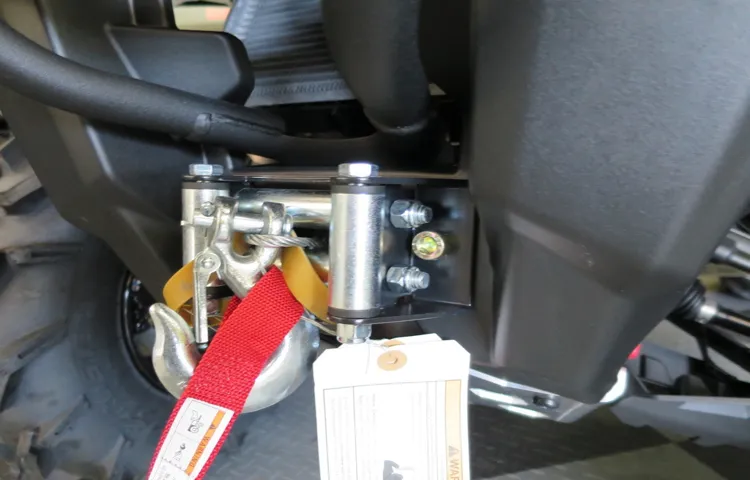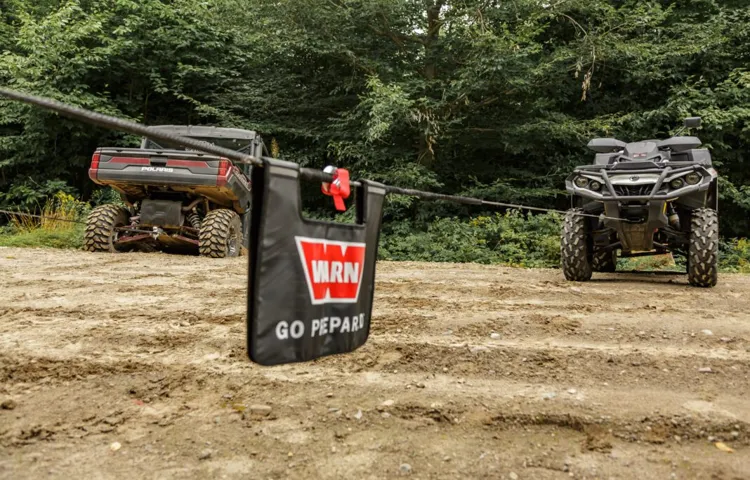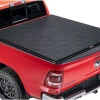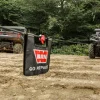So, you’ve got yourself an ATV and are ready to take it out on some thrilling off-road adventures. But wait, what happens if you find yourself stuck in a tight spot or bogged down in deep mud? That’s where a winch comes in handy! A winch is a powerful tool that can help you pull your ATV out of tricky situations and get back on track. Using a winch on an ATV may seem intimidating, especially if you’re not familiar with the equipment or the process.
But fear not! In this blog post, we’ll break down the steps on how to use a winch on an ATV, making it a breeze for you to navigate through tough terrains and conquer any obstacles that come your way. Think of a winch as your ATV’s superhero sidekick. It’s a machine with a strong steel cable attached to it, which can be used to pull or lift heavy objects.
When it comes to an ATV, a winch is primarily used to pull the ATV out of sticky situations, such as being stuck in mud, sand, or steep inclines. Now, you might be wondering, how does a winch actually work? Well, think of it like a giant fishing reel. The winch spools out the steel cable and attaches it to a sturdy anchor point, such as a tree or rock.
Then, using the power of your ATV’s engine, the winch starts to reel in the cable, pulling your ATV towards it and freeing you from whatever predicament you’ve found yourself in. To use a winch on your ATV, you’ll need a few essential items. First, make sure you have a winch installed on your ATV.
Check your owner’s manual or consult with a professional to ensure you have the right winch for your ATV model. You’ll also need a winch controller, which is usually a handheld device with buttons or switches that control the winch’s movements. In addition to the winch itself, you’ll need a strong and secure anchor point, such as a tree, rock, or another vehicle.
This anchor point should be able to withstand the force of the winch pulling your ATV. It’s essential to choose a sturdy anchor point to prevent any accidents or damage. Now that you have all the necessary tools, let’s dive into the step-by-step process of using a winch on your ATV.
Table of Contents
What is a Winch and Why Do You Need It
If you own an ATV, you might have heard about a device called a winch. But what exactly is a winch and why do you need it? Well, a winch is a mechanical device that is used to pull or lift heavy objects. It consists of a spool, a cable or rope, and a motor.
The motor powers the spool, which winds up the cable or rope. When you need to tow or recover your ATV, a winch can be a lifesaver. Whether you’re stuck in a muddy or rocky terrain or need to move heavy objects, a winch can provide the necessary pulling power.
It attaches to the front or rear of your ATV and can be operated remotely or with a control panel. So, next time you find yourself in a sticky situation, having a winch on your ATV can make all the difference.
Definition of a Winch
winch, definition, need, winching, equipment, vehicle owners, utility, off-road, recovery, heavy-duty, pulling, hoisting, cable, drum, motor, gearbox, power source, towing capacity. A winch is a versatile piece of equipment that many vehicle owners find essential, especially for those who enjoy off-road adventures or frequently find themselves in situations that require recovery or heavy-duty pulling. Essentially, a winch is a device that is used for hoisting or pulling.
It typically consists of a cable or rope that is wound around a drum, which is attached to a motor and gearbox. The power source, often the vehicle’s battery, provides the necessary energy to operate the winch. One of the main reasons why you would need a winch is for recovery purposes.
If your vehicle gets stuck in mud or sand, a winch can provide the pulling power needed to get you out of a precarious situation. A winch also has a towing capacity, which allows you to assist other vehicles or move heavy objects with ease. Whether you’re an avid off-roader or someone who works in a field that requires heavy-duty pulling, a winch can be a valuable tool to have in your arsenal of equipment.
So, next time you find yourself in need of some serious pulling power, consider investing in a winch to make your life a whole lot easier.

Different Types of Winches
winch, different types of winches
Benefits of Using a Winch on an ATV
ATV winches have become increasingly popular among ATV owners, and for good reason. A winch is a mechanical device that is attached to the front or rear of an ATV and is used to pull heavy loads or vehicles out of tough spots. But why do you need a winch on your ATV? Well, picture this: you’re out in the wilderness, enjoying a thrilling ATV ride, and suddenly you find yourself stuck in deep mud or sand.
Trying to get yourself out by brute force can be both physically demanding and time-consuming. This is where a winch comes to the rescue. With a winch, you can simply attach it to a sturdy tree or post and use its powerful pulling force to get yourself out of any sticky situation.
Whether you’re an avid off-roader or a casual adventurer, investing in a winch for your ATV can save you a lot of frustration and hassle in the long run.
Preparing Your ATV and Winch
If you’re an ATV enthusiast, it’s important to know how to use a winch on your ATV. Whether you’re navigating through tough terrain or need to rescue another vehicle, a winch can be a lifesaver. The first step in using a winch on your ATV is to make sure it is properly installed.
This involves mounting the winch to a sturdy spot on your ATV, such as the front or rear bumper. Once your winch is securely mounted, it’s important to prepare your ATV for winching. This means ensuring that the ATV is in park and the engine is turned off.
You should also engage the parking brake for added safety. Next, you’ll need to unspool the winch cable and attach the hook to the object you are winching. Make sure the hook is securely fastened before you begin winching.
Once everything is set up, you can turn on your ATV and slowly begin to winch in the cable. Take your time and be cautious as you winch, keeping a steady hand on the control switch. Remember, a winch is a powerful tool, so it’s important to use it safely and responsibly.
Choosing the Right Winch for Your ATV
winch for ATV, preparing ATV, choosing the right winch, preparing ATV and winch
Mounting the Winch on Your ATV
mounting winch on ATV
Inspecting and Maintaining Your Winch
Preparing your ATV and winch for use is crucial to ensure that they perform optimally and safely. Before using your winch, it is essential to inspect your ATV to make sure it is in proper working condition. Check the tires for any signs of wear or damage and ensure they are properly inflated.
Inspect the brakes, steering, and suspension to ensure they are functioning correctly. Additionally, check the oil, fuel, and coolant levels to ensure they are at the appropriate levels. It is also important to clean your ATV thoroughly, removing any dirt or debris that may interfere with the winch’s operation.
Once your ATV is inspected and ready to go, it is time to turn your attention to the winch itself. Start by inspecting the winch cable or rope for any signs of fraying or damage. Ensure that it is properly wound onto the winch drum and is free from any tangles or kinks.
Check the winch motor and control switch for any signs of wear or damage. Lubricate any moving parts according to the manufacturer’s instructions. Finally, test the winch by engaging and disengaging it to ensure it operates smoothly and effectively.
By taking the time to prepare your ATV and winch before use, you can ensure a safe and enjoyable off-road experience.
Using the Winch on Your ATV
If you’re an ATV enthusiast, having a winch installed on your vehicle can be a game-changer. But how exactly do you use this powerful tool? Let me break it down for you. First, you need to locate the winch control switch on your ATV.
It’s usually located on the handlebars for easy access. Next, assess the situation and figure out how you want to use the winch. Are you stuck in mud? Do you need to pull a fallen tree off the trail? Once you’ve determined your goal, approach the anchor point and secure the winch cable to it.
Make sure it’s firmly attached and the cable is free of any tangles or obstructions. Now it’s time to engage the winch. Push the control switch in the direction you want to move the cable.
If you’re pulling yourself out of a sticky situation, it’s common to reel the cable in. Conversely, if you’re using the winch to move an object, you’ll want to let the cable out slowly and steadily. Keep a close eye on the cable tension and adjust as needed.
And that’s it! With a little practice, you’ll become a winch-using pro in no time. So get out there and confidently tackle any tricky terrain or obstacle that comes your way with your trusty ATV winch.
Understanding the Controls and Features of the Winch
ATV winches are an essential tool for outdoor enthusiasts who frequently find themselves in tough terrain or sticky situations. Understanding the controls and features of the winch is crucial for effectively using it to the best of its abilities. The winch typically comes with a handheld controller that allows you to control the movement of the winch cable.
It usually has buttons or switches for operating the winch in both directions: pulling the cable in and letting it out. Some winches also come with a remote control, allowing you to operate the winch from a distance. Additionally, winches typically have a clutch mechanism that allows you to manually disengage the winch motor, enabling you to pull the cable out without using the motor.
This can come in handy if the battery is dead or if you need to free up some cable. Another important feature to look out for is the brake. The brake is an essential safety mechanism that prevents the winch cable from freely spooling out when the winch is not in use.
It ensures that the cable remains secure and prevents accidents or damage. When using the winch on your ATV, it’s important to familiarize yourself with these controls and features before embarking on your adventure. Knowing how to operate these controls properly will not only ensure your safety but also make the most out of your winch’s capabilities.
So, before you head out on your next off-road excursion, take the time to get to know your winch and its features. Keywords: ATV winches, controls, features, handheld controller, remote control, clutch mechanism, brake, operating, safety, off-road excursion.
Using the Winch in Different Situations
ATV winches are incredibly useful tools that can help you out of sticky situations when you’re off-roading. Whether you’re stuck in mud, snow, or a ditch, a winch can provide the power needed to get you unstuck. But how exactly do you use a winch on your ATV? It’s actually quite simple.
First, you’ll want to find a sturdy anchor point for your winch. This could be a tree, a rock, or even another vehicle. Once you’ve found a secure anchor, attach the winch cable to it using a shackle or hook.
Make sure the cable is properly secured before proceeding. Next, you’ll need to spool out the winch cable. Most winches have a remote control that allows you to control the cable’s movement.
Slowly spool out the cable until it reaches your ATV. Be sure to keep tension on the cable as you spool it out to prevent it from getting tangled or caught on anything. Now it’s time to attach the cable to your ATV.
Most ATV winches come with a hook or clevis that can be easily attached to a tow point on your ATV. Make sure the hook is securely fastened before proceeding. Once everything is in place, you can start winching.
Use the remote control to slowly and steadily pull the cable back in, drawing your ATV closer to the anchor point. Be sure to keep an eye on the tension in the cable and the position of your ATV, making any adjustments as needed. Using a winch on your ATV can be a lifesaver in tough off-roading situations.
Tips and Precautions for Using the Winch Safely
“tips and precautions for using the winch safely” The winch on your ATV can be a handy tool for getting yourself out of sticky situations, but it’s important to use it safely. Here are some tips and precautions to keep in mind when using the winch on your ATV. First and foremost, always read the owner’s manual before using the winch.
This will familiarize you with the specific instructions and safety guidelines for your particular winch model. Pay close attention to the maximum weight capacity and the correct method for attaching the winch to your ATV. Before using the winch, inspect the cable or rope for any signs of wear or damage.
A frayed or damaged cable could snap under tension and cause serious injury. If you notice any issues, replace the cable before using the winch. When using the winch, make sure you have a clear idea of what you’re doing before you start.
Plan out your approach and have a backup plan in case something doesn’t go as expected. It’s also a good idea to have a helper present to assist you if needed. Always wear gloves when operating the winch to protect your hands from potential cuts or burns.
The winch cable can become hot when under tension, so be careful not to touch it directly. As you operate the winch, keep a safe distance from the vehicle being pulled or any other potential hazards. Never stand directly in front of or behind the winch cable, as it could snap and whip back towards you.
Finally, make sure to properly maintain and store your winch when it’s not in use. Keep it clean and free of debris, and regularly inspect it for any necessary repairs or maintenance. Taking good care of your winch will ensure its longevity and your safety while using it.
Conclusion
And there you have it, my friends – the not-so-secret secret to using a winch on an ATV. I hope by now you’ve grasped that a winch isn’t just a fancy accessory for show-off riders; it’s a practical tool that can get you out of some seriously sticky situations. With a little bit of knowledge and a quick hand on the controls, you’ll be pulling yourself (or others) out of the mud, snow, or any other tricky terrain before you can even say “winching wizardry.
” So next time you find yourself in a tough spot, just remember these simple steps: attach the winch, engage the clutch, spool out the line, find a secure anchor, and give that winch the command to pull, baby, pull! Now, go forth and conquer the great outdoors with the power of your trusty winch. Happy winching, my fellow adventurers!”
FAQs
How do I safely use a winch on my ATV?
To safely use a winch on your ATV, first, ensure that the winch is securely mounted to your ATV. Then, attach the winch cable or rope to a sturdy anchor point. Slowly engage the winch, using the remote control or handle, to gradually pull your ATV out of any stuck situation. Make sure to always stay clear of the winch line and wear protective gloves while operating the winch.
What is the maximum weight a winch on an ATV can pull?
The maximum weight a winch on an ATV can pull varies depending on the specific winch model. However, most standard winches for ATVs have a pulling capacity of around 2,000 to 3,500 pounds. It is important to check the specifications of your winch to ensure that it is capable of handling the weight you need to pull.
Can I use my ATV winch to pull other vehicles?
Yes, you can use your ATV winch to pull other vehicles, as long as the weight of the vehicle is within the pulling capacity of your winch. However, it is crucial to ensure that the anchor point you are attaching the winch cable or rope to is secure and sturdy enough to handle the weight. Additionally, take caution when pulling other vehicles and make sure to operate the winch safely and responsibly.
How do I maintain my ATV winch?
To maintain your ATV winch, regularly inspect the winch cable or rope for any signs of wear or damage. Replace the cable or rope if necessary. Additionally, lubricate the winch gears and any moving parts with a suitable lubricant to ensure smooth operation. Keep the winch clean by removing any dirt or debris after each use. Finally, protect your winch from the elements by using a winch cover or storing your ATV in a sheltered area.
What are some common troubleshooting tips for an ATV winch?
If your ATV winch is not working properly, first check the battery to ensure it has enough power. Clean the battery terminals and make sure they are securely connected. If the winch motor is not turning, check the electrical connections for any loose or damaged wires. If the winch solenoid is clicking but the winch does not engage, verify that the winch is mounted securely to prevent any interference. If the winch still does not work, consult the manufacturer’s manual or contact customer support for further assistance.
Can I use an ATV winch for other purposes?
Yes, an ATV winch can be used for various purposes beyond recovering stuck ATVs. It can be used for hauling heavy objects, such as logs or game, or for performing tasks that require pulling force. However, it is important to ensure that the weight being pulled is within the limits of the winch’s capacity and that the winch is securely mounted to a suitable anchor point.
Are there any safety precautions I should take when using an ATV winch?
Yes, there are several safety precautions to keep in mind when using an ATV winch. Always wear protective gloves when handling the winch cable or rope to avoid injuries. Stand clear of the winch line and anyone else in the vicinity when operating the winch to prevent accidents. Make sure the ATV is in a stable position before engaging the winch. Finally, read and follow the manufacturer’s instructions and guidelines for safe operation of your specific ATV winch model.



